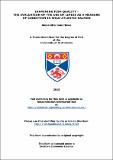Files in this item
Examining fish quality : the evaluation of the use of lipids as a measure of condition in wild Atlantic salmon
Item metadata
| dc.contributor.advisor | Todd, Christopher David | |
| dc.contributor.advisor | Hazon, N. (Neil) | |
| dc.contributor.author | Howe, Alexandra Jane | |
| dc.coverage.spatial | 150 | en_US |
| dc.date.accessioned | 2015-06-02T14:29:36Z | |
| dc.date.available | 2015-06-02T14:29:36Z | |
| dc.date.issued | 2015-06-24 | |
| dc.identifier.uri | https://hdl.handle.net/10023/6728 | |
| dc.description.abstract | Considering the response of organisms to their environment is difficult; it is made more so if population numbers cannot be closely monitored. In such cases different methods of population assessment are required. This thesis uses lipids as a measure of Atlantic salmon (Salmo salar L.) quality and investigates its usefulness in indicating fish condition. The first study examines the relationship between fish total lipid content and W[sub]R condition factor; this study clearly demonstrates that there is a significant positive relationship between the condition factor of a fish and its total lipid content. In the following study the lipid storage between the different tissues of the Atlantic salmon is considered. This indicates that the red muscle and the adipose tissues hold higher concentrations of lipid than the white muscle. However, the white muscle makes up the majority of lipid tissue mass in the Atlantic salmon so contains the bulk of stored lipid in a fish, at low concentration. The next study investigates the effect of spawning on Atlantic salmon condition. Salmon can be seen preferentially conserving lipid in their musculature and drawing down the lipid stored in their adipose tissues. The following study looked at one key lipid group, triacylglycerides, in salmon. Triacylglycerides are energetically important in fish and this study found that the spawning process depleted triacylglyceride reserves, but that the red muscle conserves triacylglycerides even after spawning. The final study considers the relationship between maternal quality and egg quality, identifying that longer Atlantic salmon produce eggs with more lipid after spawning migration. Egg lipid concentrations were comparably maintained between fish. Monitoring quality in this way is a useful tool to determine population wellbeing and help indicate where populations are compromised. | en_US |
| dc.language.iso | en | en_US |
| dc.publisher | University of St Andrews | |
| dc.rights | Creative Commons Attribution 4.0 International | |
| dc.rights.uri | http://creativecommons.org/licenses/by/4.0/ | |
| dc.subject | Atlantic salmon | en_US |
| dc.subject | Salmo salar L. | en_US |
| dc.subject | Lipids | en_US |
| dc.subject | Fat | en_US |
| dc.subject | Condition factor | en_US |
| dc.subject | Triacylglyceride | en_US |
| dc.subject | White muscle | en_US |
| dc.subject | Red muscle | en_US |
| dc.subject | Adipose | en_US |
| dc.subject | Condition | en_US |
| dc.subject | Morphological metric | en_US |
| dc.subject | Physiological metric | en_US |
| dc.subject.lcc | QL638.S2H7 | |
| dc.subject.lcsh | Atlantic salmon--Monitoring | en_US |
| dc.subject.lcsh | Atlantic salmon--Health | en_US |
| dc.subject.lcsh | Atlantic salmon--Morphology | en_US |
| dc.subject.lcsh | Atlantic salmon--Physiology | en_US |
| dc.subject.lcsh | Fish populations--Measurement | en_US |
| dc.subject.lcsh | Lipids | en_US |
| dc.title | Examining fish quality : the evaluation of the use of lipids as a measure of condition in wild Atlantic salmon | en_US |
| dc.type | Thesis | en_US |
| dc.contributor.sponsor | Natural Environment Research Council (NERC) | en_US |
| dc.type.qualificationlevel | Doctoral | en_US |
| dc.type.qualificationname | PhD Doctor of Philosophy | en_US |
| dc.publisher.institution | The University of St Andrews | en_US |
This item appears in the following Collection(s)
Except where otherwise noted within the work, this item's licence for re-use is described as Creative Commons Attribution 4.0 International
Items in the St Andrews Research Repository are protected by copyright, with all rights reserved, unless otherwise indicated.


